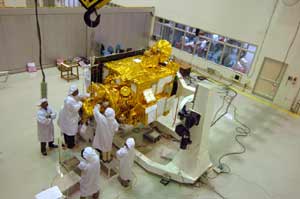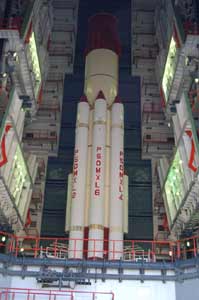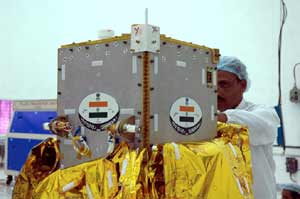22 October would be a date that should effectively be etched in every Indian's memory, for on this date India's first mission to the moon, an unmanned one, would lift off from the Earth carrying with it 11 payloads of various scientific instruments with independent objectives - from mapping the lunar surface to conducting chemical and mineralogical mapping.
 Chandrayaan-1 is scheduled to take off from Sriharikota at 6.20 am on 22 October - weather gods permitting. In case of unfavourable weather conditions the launch would be postponed to 23 October with the launch window remaining open till 26 October. Rain, thunder, lightning and cyclonic conditions would put the launch on hold since these pose significant risks to electronic circuits aboard the rocket and the spacecraft.
Chandrayaan-1 is scheduled to take off from Sriharikota at 6.20 am on 22 October - weather gods permitting. In case of unfavourable weather conditions the launch would be postponed to 23 October with the launch window remaining open till 26 October. Rain, thunder, lightning and cyclonic conditions would put the launch on hold since these pose significant risks to electronic circuits aboard the rocket and the spacecraft.
The four stages of the rocket have been completed. A regular PSLV has six strap-on motors attached to the first stage of the rocket that use nine tonnes of solid propellants.
However, for the rocket carrying Chandrayaan-1, the length of the strap-on motors has been extended from the standard 10 metres to 13.5 metres, with each using 12 tonnes of propellants. Not surprisingly, this particular PSLV, adapted specifically for the moon mission, has been designated "PSLV-XL".
How is it built? What does it have on board?
At launch the spacecraft will weigh 1,304 kilograms. However, when it reaches lunar orbit after traversing almost 386,000 kilometres from the earth, it would have lost all the weight of the propellants it burnt during its five and a half day journey, and would weigh less than half its launch weight at 590 kilograms. Its payloads collectively weigh 80 kilograms, of which 29 kilograms is that of the Moon Impact Probe (MIP).
Powered through a single solar array, Chandrayaan-1 will spend two years encircling the moon. Each revolution would be completed in 117 minutes, at an altitude of 100 kilometres above the moon's surface. Chandrayaan-1 will generate power through its canted single-sided solar array, using light-sensitive cells in its solar panels to generate 700 watts of power during peak period. During an eclipse, it will be powered by lithium batteries.
 Mission director George Koshy says Chandrayan-1 will stay in its lunar orbit for two years, though it would be able to assimilate all targeted data within a year or and a half or so.
Mission director George Koshy says Chandrayan-1 will stay in its lunar orbit for two years, though it would be able to assimilate all targeted data within a year or and a half or so.
ISRO would have about half a year of spare lunar orbit time from Chandrayaan-1.
Chandrayaan-1 is has onboard thrusters that will alter its trajectory as needed. It has an inertial measurement unit that includes accelerometers and gyroscopes to measure the attitude. Three solid-state recorders aboard the spacecraft will record data from various payloads.
The rim of the Shackleton crater: location, location, location
The Chandrayaan-1 mission will focus on exploration of the South Pole, with the moon impact probe hitting the rim of the Shackleton crater of the moon at the South Pole sometime in mid-November.
The rim of the Shackleton crater is a location on the lunar surface that has been identified by US space agency NASA as the spot to establish a possible lunar outpost sometime around 2020.
The location at the rim of the Shackleton crater has strategic advantages. That specific place on the lunar surface has sunlight available around 90 per cent of the time, translating directly into abundant solar energy for power generation. Secondly, it is close to the Malapert Mountain, a 5-km high mountain that has a direct view of both the lunar South Pole and the earth, an ideal location for a radio relay station. Moreover, the sunlit areas of the pole and its surroundings make for moderate temperatures.
The US Defence Department's Clementine Orbiter and NASA's Lunar Prospector had indicated the presence of water in the form of ice in the lunar craters. The location also heightens the possibility of finding water in the dark areas of the pole.
 ISRO, in collaboration with the US and Germany, may well be able to confirm the presence of water by sometime next year when data from instruments on board Chandrayaan-1 is analysed. If detected, water on the moon would open up ways for producing drinking water, oxygen and hydrogen fuel for bases on the moon and for rockets for future missions.
ISRO, in collaboration with the US and Germany, may well be able to confirm the presence of water by sometime next year when data from instruments on board Chandrayaan-1 is analysed. If detected, water on the moon would open up ways for producing drinking water, oxygen and hydrogen fuel for bases on the moon and for rockets for future missions.
Satish Dhawan Space Centre associate director MYS Prasad says that of the 11 payloads on Chandraayan-1, four would work to detect water – the miniature synthetic aperture radar and the moon mineralogy mapper from the US, near infrared spectrometer from Germany, and India's hyper spectral imaging camera. The synthetic aperture radar is capable of detecting ice in the permanently shadowed regions on the lunar poles, up to a depth of a few metres.
Payloads
Five of the 11 payloads have been developed with Indian contribution, with the European Space Agency having designed three, United States two, and Bulgaria one instrument respectively. These are:
Terrain Mapping Camera (TMC):
TMC is a CCD camera developed by ISRO that will map the topography of both the near and the far side of the moon. It will prepare a three dimensional atlas with high spatial and altitude resolution that will aid the understanding of the lunar evolution process as well identify regions for detailed study.
Hyper Spectral Imager (HySI):
HySI is a CCD camera that is again developed by ISRO. It will obtain spectroscopic data for mineralogical mapping of the lunar surface, and will better existing data. It will study the mineralogical composition in deep crater regions of moon's interior.
Lunar Laser Ranging Instrument (LLRI):
This ISRO-developed payload will provide data for determining the accurate height of lunar surface features, and will also help in determining the global topographical field of the moon. Additionally, it will also generate an improved model for the lunar gravity field.
High Energy X-ray Spectrometer (HEX):
The ISRO-developed High-Energy X-ray spectrometer is designed to explore the possibility of exploring the moon's polar region that are supposed to be covered with thick water and ice deposits. Primarily, it is designed to study and identify regions of thorium and uranium deposits.
Moon Impact Probe (MIP):  An Indian payload that was initiated at the instance of former President APJ Abdul Kalam, this is the probe that will actually crash-land on the moon, and will demonstrate technologies needed to land a probe at a desired location on the lunar surface. The MIP will also qualify technologies needed for future soft landing missions, and will explore the moon from close range. This module too has been developed by ISRO.
An Indian payload that was initiated at the instance of former President APJ Abdul Kalam, this is the probe that will actually crash-land on the moon, and will demonstrate technologies needed to land a probe at a desired location on the lunar surface. The MIP will also qualify technologies needed for future soft landing missions, and will explore the moon from close range. This module too has been developed by ISRO.
Crash Land plan
Once Chandrayaan-1 reaches a lunar orbit at an altitude of 100 kilometres, ISRO will issue commands to re-orient and eject the MIP, which has an onboard motor that will fire for two seconds to slow the MIP's descent velocity to 75 metres per second. During its descent to the lunar surface, the MIP will activate its video-camera which will capture images of the lunar surface that will be instrumental in ISRO's decision to pick a suitable landing site for Chandrayaan-2's rover.
The MIP's altimeter will measure its altitude from the Moon's surface every second, while a third instrument, the mass spectrometer, will sense the moon's atmospheric constituents as it free falls to the lunar surface. All data would be transmitted to Chandrayaan-1 till the MIP crash-lands on the moon, which in turn would be beamed back to earth.
Chandrayaan-1 X-ray Spectrometer (C1XS):
Chandrayaan-1 X-ray Spectrometer (C1XS) is a fructification of the European Space Agency in collaboration with the Rutherford Appleton Laboratory in the UK and the ISRO Satellite Centre. The objective of this instrument is to carry out high quality X-ray spectroscopic mapping of the moon, and a part of this payload has been redesigned by ISRO to suit Chandrayaan-1 scientific objectives.
Smart Near-IR Spectrometer (SIR-2):
SIR-2 has been developed by the Max-Planck-Institute for Solar System Science, through the Max-Planck Society, Germany and the European Space Agency. Its objective is to analyse in detail the lunar surface in various geological/mineralogical and topographical units.
Radiation Dose Monitor Experiment (RADOM):
The RADOM payload comes from the Bulgarian Academy of Sciences. It will qualitatively and quantitatively characterise the radiation environment in a region of space near the moon, and provide an estimate of the dose map around moon at different altitudes and latitudes.
Sub Kev Atom reflecting Analyser (SARA):
SARA is part of the European Space Agency's contribution to the mission, created in collaboration with the Swedish Institute of Space Physics, Sweden and Space Physics Laboratory, Vikram Sarabhai Space Centre, ISRO. This instrument will study the surface composition of the moon, the way the moon's surface reacts with solar winds and the magnetic anomalies associated with the surface of the moon.
Miniature Synthetic Aperture Radar (MiniSAR):
MiniSAR comes from the Applied Physics Laboratory, Johns Hopkins University and Naval Air Warfare Centre, all the way from the US through NASA. This payload aims to detect water ice in the permanently shadowed regions on the lunar poles up to a depth of a few meters. This radar mapper would allow viewing of all permanently shadowed areas on the moon, regardless of whether sunlight is available or whether the angle is unsatisfactory.
Moon Mineralogy Mapper (M3):
M3 comes aboard the mission from Brown University and Jet Propulsion Laboratory in the US through NASA. The spectrometer will assess and map lunar mineral resources at high spatial and spectral resolution to support planning for future, targeted missions, and will also aid in the characterisation and mapping of lunar materials in context of moon's early geological evolution.
Exploring the moon's potential for energy
Speaking to the media, Vikram Sarabhai Space Centre's director Dr K Radhakrishnan and the director of the Satish Dhawan Space Centre, MC Dathan, said India's pioneering lunar mission, four decades subsequent to man's conquest of the moon, will be important for a number of reasons.
One of the foremost reasons, says Radhakrishnan, is the fact that the moon could be a major source of energy for the human race in times to come. Mankind, according to him, is already grappling with questions about alternative energy sources to fulfill the burgeoning demand for energy as a replacement for fast depleting fossil fuel reserves on earth.
Earlier lunar missions had detected the presence of helium in the moon's surface, and there could be future explorations that would work on getting it to earth to harness its properties and process it.
A second reason is that the moon is an intermediary planet that would be a staging area for future explorations. It could also serve as a scientific and technological exercise in man's dream of reaching out to other planets such as Mars.
Chandrayaan-1 is also the first step towards a manned mission to the moon. India plans to send an astronaut into space by 2014, and a manned mission to the moon by 2020.
Waste of money? No way!
The Times reported that critics of India's space programme have billed Chandrayaan-1 as a "waste of money" in a country where 800 million of a total population of 1.1 billion live on less than $2 a day. However, advocates for the programme counter that India has a revenue generating commercial satellite launch operation, and the scientific benefits of the space programme have played a key role in the development of the country's IT industry.
Further, they cite India's seven earth-observation satellites as the largest of its kind globally, even as India's space programme trails its large neighbour's, China. China is the third nation, after the US and the former Soviet Union, to put a man into space aboard its own launch vehicle. Chinese leaders have hailed the space walk by a Chinese 'taikonaut' that was conducted on 27 September as a great victory, even though it came decades after those conducted by the former USSR and the US.
Dr APJ Abdul Kalam's views
In a recent interview with the Times of India, former president of India Dr APJ Abdul Kalam shared his excitement about the lunar mission, visualising it as a mission to boost space research, and motivating more budding scientists to take up careers in the field.
He said that India has the capability to stand tall in the space exploration domain, with the "capability to build any type of launch vehicle, any type of spacecraft and launch it not only in earth's orbit, but also in the lunar orbit."
Kalam said that the lunar mission would signal India's readiness to be a partner in international space missions, enabling the evolution of the Earth-Moon-Mars complex, which in turn would lead to inter-planetary economic activity and the evolution of an alternative habitat.
Explaining the importance of the lunar mission, Kalam said that as civilisation spreads through the solar system, the moon would provide the main link between the Earth and its "scattered children", becoming a telecommunications hub for inter-planetary communications.
Chandrayaan-2: Planned Sequel
The Moon Impact Probe (MIP), the 29-kilogram payload, would be the first object left behind by India on another celestial body, and is painted with the colours of the Indian national flag. Built by the Vikram Sarabhai Space Centre, Thiruvananthapuram, the MIP is actually a technological forerunner to India's Chandrayaan-2 mission that will aim to deploy a Russian-built lander or a rover on the Moon.
ISRO signed up with Russian federal space agency Roskosmos last November for a joint lunar mission for Chandrayaan-2. As part of the agreement, ISRO will build the mother-spacecraft, while Roskosmos will build the lander/rover that will detach from Chandrayaan-2 and land on the moon.
The Chandrayaan-2 rover will move around on the lunar surface, analysing soil samples and sending data about its chemical analysis to Earth. Chandrayaan-2 would head for the moon sometime around 2011-12 aboard an Indian Geo-synchronous Satellite Launch Vehicle (GSLV).

No comments:
Post a Comment